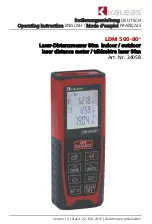
Principles of Operation
67
Single-Value Operations
Single-value operations are the simplest to use but offer the least flexibility and efficiency. Use
software to specify the analog output channel, and the value to output from the analog output
channel. Since a single-value operation is not clocked, you cannot specify a clock source,
trigger source, or buffer.
Single-value operations stop automatically when finished; you cannot stop a single-value
operation.
Continuous Output Mode
Use continuously paced analog output mode if you want to accurately control the period
between D/A conversions or write a waveform to one or more analog output channels.
Use software to configure the output channel list, as described on
. Then, allocate a
buffer that contains the values to write to the analog output channels that are specified in the
output channel list. For example, if your output channel list contains DAC0 and DAC1,
specify your buffer as follows: first value for DAC0, first value for DAC1, second value for
DAC0, second value for DAC1, and so on.
When it receives the software trigger, the module starts writing output values to the analog
output channels specified in the output channel list. The operation repeats continuously until
no more buffers are on the subsystem queue or you stop the operation. Refer to
more information about buffer modes.
Note:
Make sure that the host computer transfers data to the analog output channels fast
enough so that they do not empty completely; otherwise, an underrun error results.
To select continuously-paced analog output mode, use software to specify the following
parameters:
• Set the dataflow as Continuous.
• Set WrapSingleBuffer to False to use multiple buffers (a minimum of two buffers is
recommended in this mode), or to True to use a single buffer.
• Set the trigger source as a software (internal) trigger.
• Set the clock frequency.
To stop a continuously paced analog output operation, you can stop sending data to the
module, letting the module stop when it runs out of data, or you can perform either an orderly
stop or an abrupt stop using software. In an orderly stop, the module finishes outputting the
data in the buffer, then stops; all subsequent triggers are ignored. In an abrupt stop, the
module stops outputting samples immediately; all subsequent triggers are ignored.
Summary of Contents for DT9812 Series
Page 1: ...DT9812 UM 20769 R DT9813 and User s Manual DT9814 Series Title Page ...
Page 4: ......
Page 12: ...About this Manual 12 ...
Page 13: ...13 1 Overview Key Hardware Features 14 Supported Software 15 Getting Started Procedure 16 ...
Page 17: ...Part 1 Getting Started ...
Page 18: ......
Page 26: ...Chapter 2 26 ...
Page 53: ...Part 2 Using Your Module ...
Page 54: ......
Page 76: ...Chapter 5 76 ...
Page 88: ...Chapter 6 88 ...
Page 94: ...Chapter 7 94 ...
Page 113: ...113 B Screw Terminal and Connector Pin Assignments ...
















































